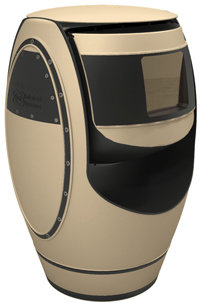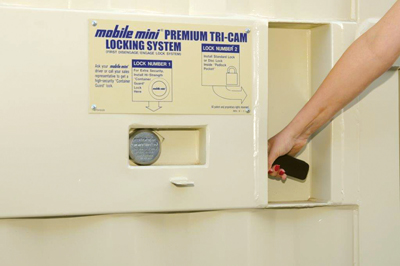 |
| Theft, intrusion and property damage are major mine security concerns, but there are economic issues, and benefits, as well. Some companies report reduced contractor costs simply from better access control information, showing who is actually on site and for how long. |
Effective mine security requires preparation, awareness and prevention. Here’s a look at some of the latest services and products that can help mine operators meet the challenge.
In addition to all of the usual financial and technical concerns associated with project development and mine operations, mineral producers today have to cope with another rapidly expanding and complex challenge: How to define, budget, and tailor security programs to protect assets from both external and internal threats.
Whether it’s as complex as detecting and fending off enterprise computer-network intruders, as potentially dangerous as thwarting property incursions by angry protestors or artisanal miners, or as basic as preventing pilferage of parts, supplies and tools by workers, it’s a puzzle that must be solved—even though the most effective methods of protection may vary significantly from mine to mine, region to region, and by predominant local cultural practices and beliefs.
A typical project or mine site generally has numerous contractor and vendor employees entering and leaving the site on a daily basis, stores materials on site that attract the attention of thieves—and regulators—such as refined and highly valuable metals and explosives, and are increasingly located in remote areas in which the only infrastructure available is whatever the mine has itself installed to carry out production.
Large producers such as BHP Billiton, Rio Tinto or Vale generally have the resources, budget and access to expert assistance that enable them to implement effective, enterprise-wide security practices and policies. For mid-level or smaller companies, however, security issues can involve uncomfortable decisions about how and when to expend limited resources to achieve basic levels of protection. Shareholders may be unhappy with noncore-business expenditures that don’t contribute directly to output, but they may be even more displeased if lax attitudes toward security or uncontrolled activities on site cause bottom-line damage.
Industry suppliers aren’t exempt from security problems, either. Siemens, for example, is used to solving large-scale security problems for customers. However, even Siemens recently had to release a security update to counteract the “Heartbleed” software threat to its SIMATIC WinCC Open Architecture, a supervisory control and data acquisition (SCADA) system that’s used in a large number of industries. Heartbleed exploits a security flaw in software used by roughly two-thirds of all websites, and can be used to extract passwords, encryption keys and other potentially sensitive information. This flaw also affects desktop and mobile applications, embedded systems like routers, hardware appliances and industrial control systems.
Corporate security increasingly demands day-by-day or even hour-by-hour attention to data-delivery integrity as mining becomes more dependent on expert systems, autonomous operations and the Internet of Things in general. Recognizing the challenge—particularly to smaller enterprises—Siemens and McAfee, a division of Intel Security, also have teamed up to provide security solutions and services for industrial customers. They emphasized the fact that many industrial customers lack the resources necessary to respond efficiently to security incidents and do not have access to the global threat intelligence that would allow proactive defensive measures. This critical information is needed in order to keep up with evolving government regulations, industry standards, sector specific best practices, and other risk information necessary for making informed business decisions.
Siemens said cooperation with McAfee will complement its service offerings by leveraging security solutions such as next-generation firewall, security information and event management (SIEM), endpoint security, and global threat intelligence as part of its Managed Security Service, as well as offering professional services.
GE, another large industry supplier, recently announced a new platform of industrial wireless routers that are designed to allow its mining customers to cost-effectively expand their communication infrastructures securely, using a range of technologies.
The MDS Orbit Platform is GE’s next-generation wireless communications solution that integrates cellular, private, licensed, and unlicensed networks in one device, delivering secure communication between field crews and industrial equipment, and bringing asset and operational data from the field to the operations center. GE said the MDS Orbit Platform’s comprehensive security framework provides customers the functions and tools they need to meet current cybersecurity requirements and regulations.
Offering -40°C to +70°C temperature ratings and a rugged, compact design, the products in the MDS Orbit Platform are claimed to be ideal for mission-critical operations and customers who operate in challenging terrains and environments.
 |
| The Spynel infrared camera system can detect human presence 6 km away. |
High-tech Detection
Last year at a regional mining trade show in the western U.S., HGH Infrared Systems and STARA Technologies demonstrated—and reportedly received a high degree of interest in—an automated intrusion detection and tracking system that employs a long-wave infrared camera system claimed to be capable of detecting human targets up to 6 km away, offering 360ᴼ panoramic coverage. The Spynel system, according to Cambridge, Massachusetts-based HGH, offers a state-of-the-art method for enhancing the safety of workers, equipment and materials that are often widely dispersed on very large sites. It can detect vehicles up to 12 km away and maintains its efficiency both day and night or during inclement weather. HGH said it had previously successfully demonstrated the system for perimeter protection at one of the largest gold mines in Africa.
However, not all site security problems require high-tech solutions. At the most basic level, sometimes one of the most important elements of a security program is simply to prevent what’s on site from leaving the site without authorization, during shift change or in the dead of night.
Mobile Mini, an Arizona, USA-based company with an international presence, specializes in providing secure storage and office solutions. The company said its inventory of more than a quarter-million units primarily consists of remanufactured and differentiated steel portable storage containers built according to ISO standards, as well as other types of steel containers, steel security offices and mobile offices. Many of the units are enhanced with the addition of a proprietary locking and easy-opening premium door system.
Mobile Mini claims that its patented Tri-Cam locking system provides “bank vault” security for valuable assets. The system includes interlocking bars that secure the entry’s top, bottom, and sides from the inside, and can be used either with a conventional padlock or Mobile Mini’s hardened-steel ContainerGuard Lock, which features a hidden six-piston tumbler system and is claimed to be virtually drill-proof.
Mobile Mini said it has introduced a number of innovative products in this area, including steel general storage units, record storage units and combination storage/office units. Storage units feature high-security doors and locks, electrical wiring, shelving, folding work tables and air filtration systems. The company’s steel security office/storage combination and security office units range from 10 to 40 ft in length, in various configurations. Office units are equipped with electrical wiring, heating and air conditioning, phone jacks, carpet or tile, high-security doors and windows with security bars or shutters. They can also be equipped with sinks, hot water heaters, cabinets and restrooms.
 |
| Mobile Mini says its portable steel storage buildings can be secured with either a conventional padlock or its patented Tri-Cam locking system. |
For facilities that require access notification and reporting capability, CyberLock, Inc., a security systems supplier, recently reported several software enhancements to its CyberAudit Professional management system. The CyberAudit Professional management software is part of a smart key solution comprising electronic locks and programmable keys. The software allows users to assign key access schedules, set expirations, add new CyberLock electronic lock cylinders to the system, monitor employee and contractor access activities, and generate audit trails and custom reports.
CyberAudit Professional 3.0 software, according to the company, now offers enhanced reporting and notification capabilities, compatibility with CyberKey Vaults and Flex System input and output devices, and provides activation for the Flex System Door & I/O module relay device.
By using the CyberLock Flex System Door and I/O module, organizations can integrate with certain third party-compatible access control devices, making the technology more suitable for organizations looking for a cost-effective way to expand their access control systems. Functions of the Door and I/O module include locking and unlocking doors, arming and disarming alarms, and activating other relay-based devices.









